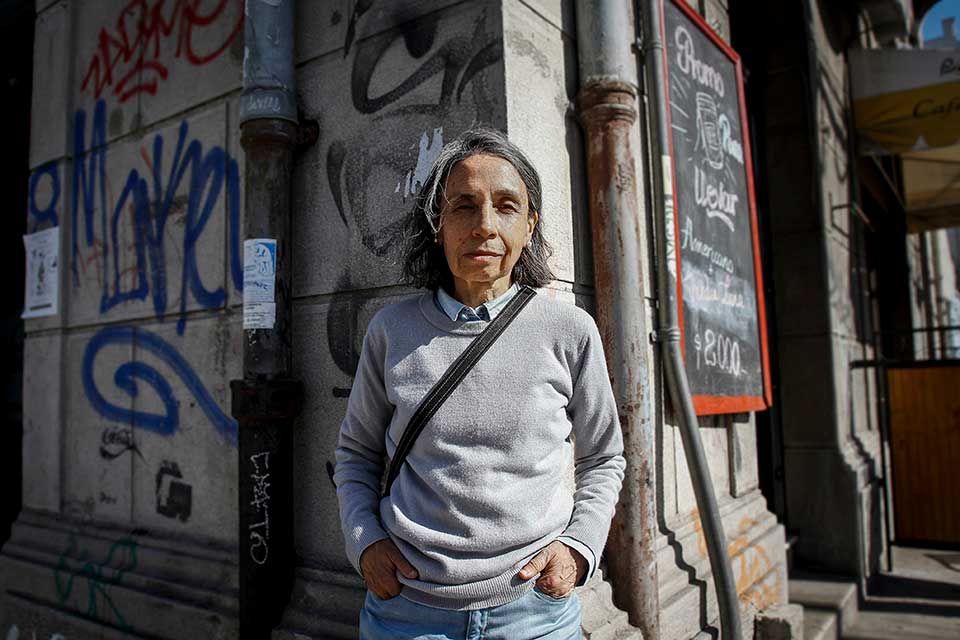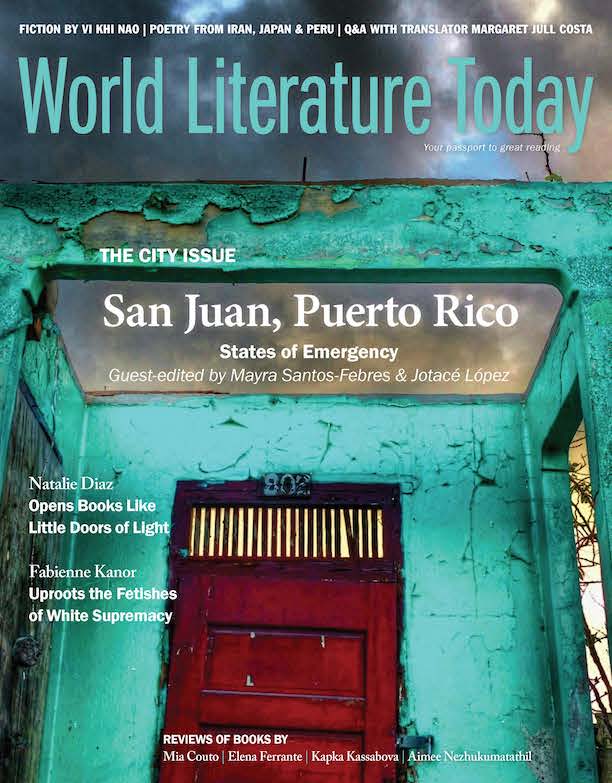The Insolent Gaze of Chilean Poet Elvira Hernández

When police are blinding protestors on Chile’s streets, eyes like poet Elvira Hernández’s become more important than ever.
As I write this, Chile is burning. The streets are burning, the monuments, the symbols, and signs of an abusive and unequal system that has been in place since Pinochet’s dictatorship. People are saying “no more”; they are taking to the streets even though the government is replying with violence. There have been deaths, wounded. A couple of hundred people have been blinded by police pellets. Amidst all this, graffiti has filled the city’s walls. People write their demands, their exhaustion, their poetry.
I can imagine Elvira Hernández (b. 1951, Lebu) reading the walls and also writing, scribing down what she sees in the streets of Santiago. The smoke, the graffiti, the repression, the people asking, in the thousands, the millions, for a change. Hernández started writing poetry under Pinochet’s dictatorship; soon after she was detained by the regime’s secret police, which supposedly mistook her for a wanted guerrillera. She was released after five days, and not long after that she began writing La bandera de Chile (1991; Eng. The Chilean Flag, 2019), a collection of poems that would circulate for years by word of mouth, in mimeographed copies and loose pieces of paper. The book, written in 1981, was published ten years later by an Argentine publishing house. It was not until 2010 that the first Chilean edition appeared.
Right before La bandera de Chile was written, something broke. More than one thing, really. The country, the people, their language, and their poetic tradition. After the coup d’état, Hernández said in an interview, “you couldn’t write as before. It would have been like eating a plate of stale food.”1 The old way of writing, the bombastic Nerudian style with his poet-as-prophet voice, was useless after the political violence that the terrorist state imposed on the country. Hernández said that Neruda’s majestic metaphors and the lushness of his images couldn’t speak to a ravaged country.2 For her, the model that made more sense after the coup was the one installed by Nicanor Parra’s poetry or, as it is called, by his antipoesía. Parra brought the streets, the ugliness, the absurdity, and the small things of daily life to poetry, countering the idea of the poet as a little god, as the creator of new worlds, or as an anointed one entitled to be the voice of everyone.3
Hernández is not the prophet-poet that speaks for us; rather, she is one of us.
Parra’s dark humor and the everyday language he had brought to poetry were part of the material that Hernández worked with. The rest—and perhaps the more important part—came from the reality around her and her particular way of seeing her surroundings.4 “I don’t have other eyes to see what I saw,” she once wrote, but her eyes are sharp and dive deep into reality. She reads the signs of daily life—a flag, a bird, sports, the coming of days and the falling of nights—and creates with them uncanny images charged with what runs deep within us Chileans. She doesn’t speak—not often at least—of a place of personal intimacy; her voice is her own and at the same time the voice of the collective: “I never heard ‘little god’ / never heard ‘little me’ either. / A small grain of salt that has to go back to its ocean.” Hernández is not the prophet-poet that speaks for us; rather, she is one of us, always trying to go back to her ocean, where all of us are, swimming, being waves, foam, fish, floating and trying not to sink. The difference is that Hernández writes her way back. And she started that writing with a flag:
It is not devoted to a single person
the Chilean flag
it surrenders itself to anyone
who knows how to seize her.
the seizing of the flag5
Hernández’s flag—or the way she sees and portrays the Chilean flag—is one that doesn’t have a will or even a distinctive subjectivity. This flag—blue, red, and white—is just a piece of cloth that hangs from a pole and sometimes gets carried by the wind, the same way she is carried by the forces of history. I write “she” because that is what Hernández sees in this flag: a cloth, a bit of fabric that gets treated as women have been treated in Chile and so many other parts of the world too:
The Chilean flag is hanging from two buildings
her fabric swells up like an ulcerated belly—falls
like
an old tit—
like a circus tent
with her legs in the air she has a slit in the
middle
little coochie for the air
a little hole for the ashes of the General
O’Higgins
an eye for the Avenida General Bulnes
The Chilean flag is on her side
forgotten6
The flag hangs like washcloths on a laundry line, the result of women’s work, of hands reddened by soap, friction, and cold water. Instead of flying proud and powerful, this flag swells like a poorly fed stomach and falls like the breast of an old, wasted woman. Yet at the same time, she—the flag/the woman—has to be ready to perform and entertain, to also be a recipient for the ashes of the Men of the Republic, the ones who built what is now being burned by people tired of abuse, of being treated as disposable, forgotten for so long with their cold and fear and hunger. Because even though Hernández wrote La bandera de Chile during the 1980s, it can be read as if it were written today. “The Chilean flag is reversible . . . / The Chilean flag is the perfect division,” one of the poems says, and, really, what country doesn’t have a symbol that can be read so differently depending on where you read it from?
Now we can see two Chiles seizing the flag. One Chile does so from La Moneda, the government house, and involves the smallest and richest part of the country, the one that doesn’t want to lose its privileges, the false idea that they are the ones that shape the country. The other Chile is the more populated one; it’s the country that has seen public education disappear, resulting in education as a privilege rather than a right; the same country that has to buy basic food on credit and that sees its old people working hard until their last days, trying to survive on the miserable pensions that the neoliberal system has engineered for the country. That Chile is the one now making the Chilean flag swell proud in the air, while people demand a new and more equal order.
It’s complicated, and it doesn’t make sense, to talk about Hernández’s poetry without talking about Chile’s reality. She is an enormous poet of the day-to-day of a country that struggles but stands. Her gaze is always upon it, on its land and also on the sky, when she even has time to stargaze.
I didn’t see the Halley on the first day . . .
I didn’t see it.
I didn’t see it
with my head buried in papers
words without sense, words
and I missed that black wonder dressed in smoking
that nocturnal party, that darkish riot, ah for
doing extra hours and more hours
collect and recollect money and make
cash and the fact
that the world would keep existing for me.
This poem is from ¡Arre! Halley ¡Arre! (1986; Giddyup, Halley, giddyup!), a collection in which she talks about the Halley’s Comet fever that Chile experienced in 1986, the last time this celestial body appeared in the earth’s skies. Hernández redirects the reader’s eye to what was important then: the comet was crossing the sky while underneath, on land, people were trying to feed themselves and to survive the dictatorship. The poetic voice in the poem is trying to make a living, so she doesn’t have time to look at the stars. And she is also too conscious of what is happening around her, a reality too close for her to be able to look away. The last line of the poem reads: “They say that it was like a severed head appearing / without wanting to ever disappear.” Here, the comet becomes the head of a victim of the dictatorship, one of the thousands that disappeared under state terrorism, and Hernández masterfully weaves together the banality of the enthusiasm about a comet—fed by TV and newspapers—and the nuances and horrors of daily life in dictatorial Chile.
Sometimes, the burden she writes about is more vague, almost imperceptible in the daily order of things, like in this poem from El orden de los días (1991; The order of days):
domestic insomnia clouds his days . . .
shirts hung out are lashed bodies
physics doesn’t hold hands with man
the pots don’t fill up just with water
this day doesn’t end
Again, poverty and hunger are at the center of the poem. Hernández can write about birds she sees from her window, Halley’s Comet, a trip, Santiago, but she never stops seeing what is affecting the collective, the ocean she returns to, word by word. She wrote in Pájaros desde mi ventana (2018; Birds from my window) that “Poetry is not thematic. / Poetry talks about everything at the same time. / Poetry is a box of surprises.” Hernández’s poetry is truly filled with surprises, complex ideas, and the dark places of routine. Running through all this, there is always a deep political consciousness and commitment. She said when writing about the year of the coup d’état: “I suspect that it wouldn’t have mattered to know that Goethe advised poets against taking an interest in politics. We were in a region in America where writing and being involved in the Latin American people’s struggle was presented as unbreakable.” But what happens when the struggle never ends?
When struggle doesn’t end, poetry like Hernández’s becomes always political without sermonizing.
After the dictatorship, the new democratic governments from the center-left coalition and, later, the right dressed Chile up in the shiny clothes of neoliberalism, much like Pinochet had done during his regime. The country became wealthier, but the inequal distribution of riches favored just a few and condemned the rest of Chile to precariousness. Inequality became even more acute than before. So, when struggle doesn’t end, poetry like Hernández’s becomes always political without sermonizing. It is timeless, dedicated to daily life, its subtleties, its ugliness, and, also, its greatness, like in this poem from Pájaros desde mi ventana:
This morning
with the morning light
the tarabilla has arrived
to knock on the eastern window.7
We still believe in signs
and we walk into the day
hoping.
This book about birds is—as of now—the most recent one published by this poet whose work was for decades an open secret among readers and writers of poetry.8 It is also one of her most intimate books. We see what she sees from her window or, rather, windows, because the poems were written over four years and include some of her travels. But with Hernández it is never just about seeing; there is always something more in the images her poetry conveys. For example, we can imagine the eyes that see birds drinking from a drop of water, but those eyes bring us to a further sight. The poet’s gaze pictures the birds thinking that they need to transform themselves, to go back to being dinosaurs, bigger, more powerful, ready to fight against what plunders their soil, water, and sky, in short, the Chilean environment. This same preoccupation is in another poem of this collection:
They are gone, the queltehues of Luis Carrera.9
To their nook arrived
the electric lawn mowers
the garden lights
the dogs that go down to pee from the high-rises.
They are gone
their elegant frame and
their curtsies.
Hernández’s poetry tells us once and again that poetry talks about many things at the same time. It talks about what it sees outside a window, over our heads, in the streets, in the people’s stomachs. It also can tell us about Elvira Hernández, who was not born Elvira Hernández but María Teresa Adriasola. She chose her pen name to write poetry and to let Adriasola write literary criticism, but now Hernández has taken over all of her work. It is her, Hernández, whom I think of while reading her poetry. It’s Hernández whom I imagine seeing the streets of Santiago burning, writing down what she sees these days, using her eyes once more to register the authority’s deafness and violence. Now that the police are deliberately blinding people who protest, eyes like Hernández’s, eyes that see deep and can tell others what is happening, are more important than ever.
Bergen, Norway
1 Carola Solari, “La poeta ultra secreta,” Revista Paula, September 2017.
2 Elvira Hernández, “Gente del 73,” Guaraguao, año 9, no. 21 (Winter 2005): 89–99.
3 Vicente Huidobro (1893–1948) was a Chilean poet of the avant-garde that created the movement known as creationism, where the poet was called to behave in a godlike fashion and create new worlds.
4 During Pinochet’s dictatorship there was a strong group of poets writing from Chile and exile. Elvira Hernández’s work has been usually connected with the work of a group of poets labeled as neo-avant-garde. Other poets bound together under this category include Juan Luis Martínez, Soledad Fariña, and Carlos Cociña.
5 Unless otherwise noted, translations are my own.
6 Elvira Hernández, The Chilean Flag, trans. Alec Schumacher (Kenning Editions, 2019).
7 Tarabilla is a common bird known by the scientific name of Saxicola torquatus.
8 In 2018 she finally received her first big literary prize in Chile, and, almost at the same time, she was also awarded the Pablo Neruda Ibero-American Poetry Prize. Not that she frets about prizes.
9 Queltehues are common birds in South America. They are part of the bird family called lapwings.











